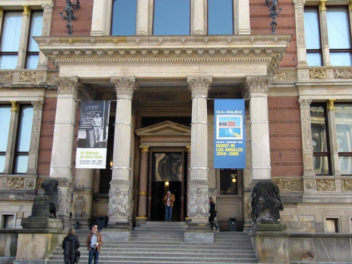Digital art history project draws on Getty Vocabulary data to map the migration of artists across 3,000 years

Birth to death migration in Europe, according to the Getty’s Union List of Artist Names, cumulated over all time to CE 2012. Blue dots indicate the births of notable individuals; red dots indicate deaths. © Maximilian Schich, 2014
What defines a cultural center? Location? Money? Population? A recently published study says it’s simply this: a place where large numbers of notable people have died.
This finding is one of several in a new Science magazine report that combines art history, sociology, and network science to map the cultural history of Europe and North America across 3,000 years. By analyzing a seemingly simple set of data—the birth and death dates and places of notable artists, scholars, and writers—the authors were able to visualize large-scale patterns in Europe’s cultural life. Centers such as Berlin, Moscow, and London emerge as clear “death attractors,” meaning that they draw artistic figures away from their birthplaces to live, work—and eventually die.
The data for the study was drawn from Freebase.com, the Allgemeines Künstlerlexikon/Artists of the World, and the Getty’s Union List of Artist Names (ULAN®), an electronic thesaurus containing key information on nearly 300,000 artists, architects, patrons, and other figures in the art world.
For the study, art historian and network analysis expert Maximilian Schich from the University of Texas at Dallas and six collaborators mapped the shifting epicenters of Western art over the centuries: Rome in the classical world, Florence in the Renaissance, Paris in the 18th and 19th centuries, New York and Los Angeles in the 20th and 21st centuries. Some places, notably France, have a “winner-takes-all” geographic pattern, concentrating the majority of cultural ferment in a single city (Paris). Others, such as the German-speaking countries, brew innovation in multiple centers (Munich, Berlin, Vienna, Nuremberg), revealing what the authors call a “fit-gets-richer” system. Both terms are borrowed from the field of network science and applied to art history.

Massive centralization towards Paris (left) versus multi-centric competition in Germany (right). © Maximilian Schich, 2014
These patterns are ones that art historians have long known and studied, but the study by Schich et al. provides a new, statistically rigorous view. It also underscores the advances that humanities researchers can now make by combining traditional qualitative methods with quantitative techniques drawn from informatics, statistics, and network analysis. Call it digital humanities—or cultural science.
“A Network Framework of Cultural History” appears in the August 1 issue of Science, making it one of the first art history reports to be published in a peer-reviewed science magazine. The authors’ project website is at cultsci.net.




Europe without Constantinople/Istanbul! This City was the most important city in Europe and one of the Worlds most important cities for a long time with many important people! And later the Osmans with their scientists, writers, artists…! It seems that this project is not about Europe. Its about the christian part of Europe + USA. Maybe Propaganda for TTIP economic between US and EU that nobody in the EU wants.
Thanks for raising this issue! An explanation for this fact is found in the supporting online material of the Science paper. Per Dr. Schich:
—Annelisa / Iris editor